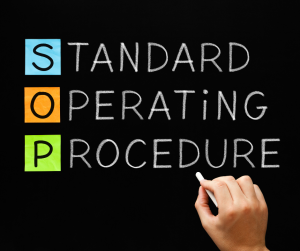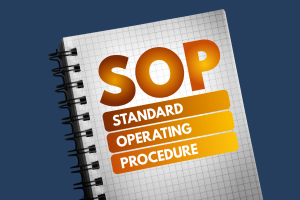The Importance of SOPs and Everything You Need to Know About Writing Them
Are you an entrepreneur who feels overwhelmed by the never-ending list of tasks that come with running your business and business processes? Do you find yourself constantly juggling multiple responsibilities, struggling to find time to focus on the aspects of your business that you love? If so, then it’s time to embrace the power of Standard Operating Procedures. This blog post will explore why SOPs are important and provide you with everything you need to know about writing them.
Why Are SOPs Important? 
Imagine having a step-by-step guide for every one of your business processes. From onboarding new clients to handling customer inquiries, having well-documented processes ensures consistency and efficiency in your operations. Here are a few reasons why they are essential:
- Streamline Your Operations: SOPs provide clear instructions on how to perform specific tasks that make up your business processes. Standardizing processes eliminates guesswork and reduces errors, saving both time and money.
- Ensure Consistency: With this documentation in place, you can ensure that every team member follows the same procedures. This leads to consistent outcomes, regardless of who is performing the task.
- Facilitate Training and Onboarding: When new team members join your business, they can quickly get up to speed by referring to the SOPs. This reduces training time and ensures that everyone is on the same page.
- Improve Scalability: SOPs become invaluable for scaling operations as your business grows. They allow you to easily delegate tasks and bring new team members on board without sacrificing quality or efficiency.
- Increase Business Value: Well-documented SOPs demonstrate that your business and business processes are organized and can operate smoothly without relying solely on key individuals. This increases its value in the eyes of potential investors or buyers.
How to Write an Effective SOP
 Now that we understand the importance of SOPs, let’s dive into the process of writing them. Here are the key steps to follow:
Now that we understand the importance of SOPs, let’s dive into the process of writing them. Here are the key steps to follow:
- Identify the Process: Select specific business processes you want to document. It could be anything from your client onboarding process to your social media content creation workflow.
- Break it Down: Once you’ve chosen a process, break it down into smaller, manageable steps. Think about each action required to complete the task and list them in sequential order.
- Be Clear and Concise: Write each step in clear and simple language, using bullet points or numbered lists for easy readability. Avoid jargon or technical terms that may confuse your team members.
- Include Visual Aids: Whenever possible, include visual aids such as screenshots, diagrams, videos, or flowcharts to enhance understanding. Visual representations can make complex business processes much easier to follow.
- Test and Revise: Before finalizing your SOP, test it out yourself or have someone else follow the instructions. Based on feedback, make any necessary revisions and ensure that the process is accurate and easy to follow.
- Update Regularly: As your business evolves, so will your processes. Reviewing and updating your SOPs regularly is crucial to reflect any changes or improvements in your workflows.
Tips for Writing Effective SOPs
Writing effective SOPs requires attention to detail and clarity. Here are some additional tips to help you create SOPs that are easy to understand and implement:
- Use Action Verbs: Begin each step with an action verb, such as click, type, or review. This makes the instructions more actionable and concise.
- Provide Examples: Whenever possible, provide examples or sample documents that illustrate how tasks should be completed. This helps clarify expectations and reduces confusion.
- Consider Different Learning Styles: People learn differently, so consider incorporating multiple formats into your SOPs, such as written instructions, visual aids, and video tutorials.
- Seek Feedback: Don’t be afraid to ask your team members for feedback on the clarity and effectiveness of your SOPs. Their insights can help you refine the processes and make them even better.
- Keep Them Accessible: Store your SOPs in a centralized location that is easily accessible to all team members. Consider using cloud-based document management systems or project management tools for easy retrieval.
Conclusion
In conclusion, Standard Operating Procedures are invaluable for entrepreneurs looking to streamline their operations, ensure consistency, and scale their businesses. By following the steps outlined above and incorporating best practices for writing effective SOPs, you’ll be well on your way to creating a more efficient and organized business. So, don’t wait any longer – start writing your SOPs for business processes today and reclaim your time to focus on the aspects of your business that truly inspire you!
Now that you have the low-down on the importance of using SOPs for your business processes, you can download my handy Guideline for SOPs with a free SOP template!
Stop Stalling, Start Achieving: Let’s CRUSH Your Goals. Schedule your FREE Discovery Call. What do you have to lose? Except the frustration of unachieved goals.
OTHER BLOGS TO CHECK OUT:
WORK SMARTER: 7 PROVEN STRATEGIES FOR EFFECTIVE TASK MANAGEMENT
UNLOCKING BUSINESS EFFICIENCY: THE POWER OF ONLINE BUSINESS MANAGEMENT SERVICES







